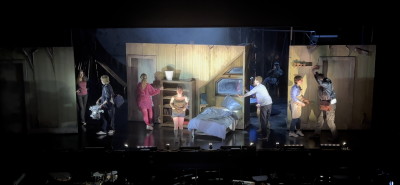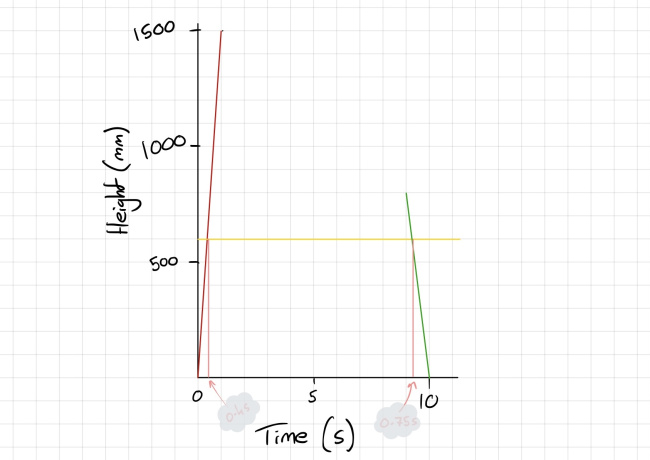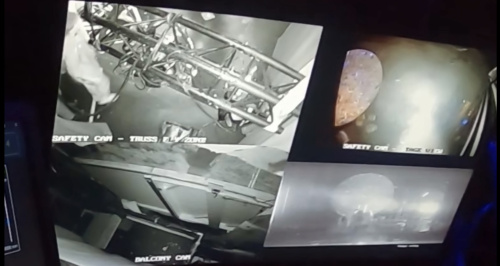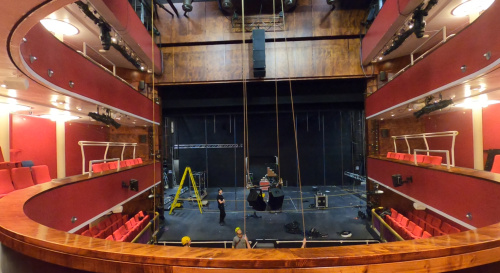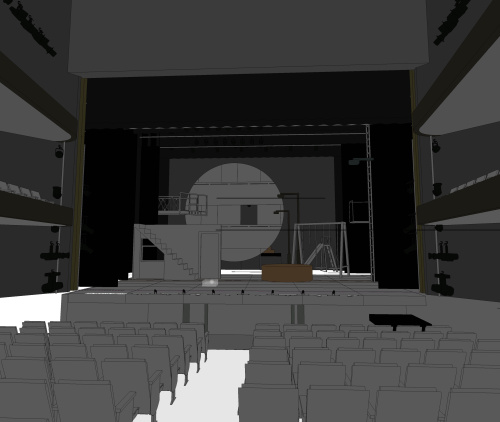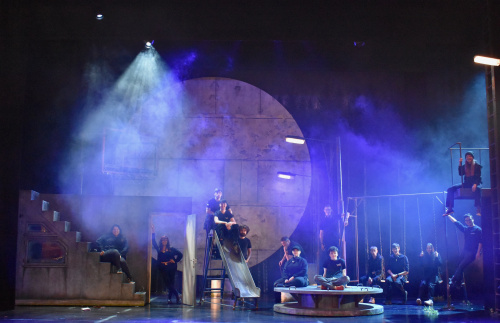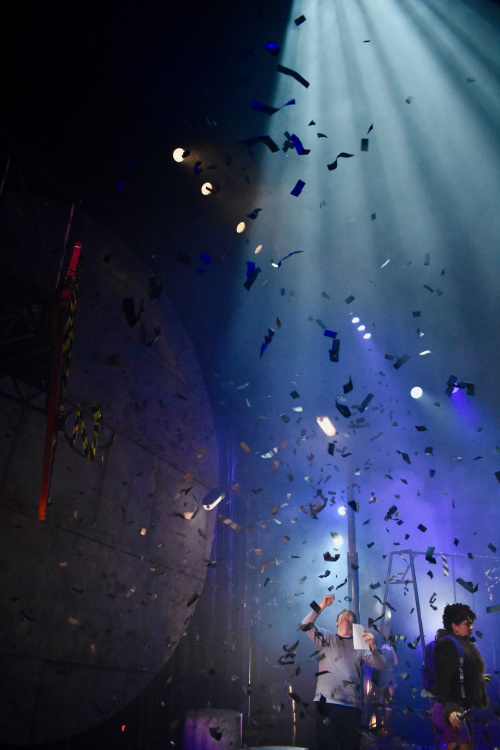Into The Woods 2023: Difference between revisions
| (63 intermediate revisions by 5 users not shown) | |||
| Line 26: | Line 26: | ||
|- | |- | ||
|'''Designer''' <div style="text-align: centre;"> [[Alex Green]] </div> | |'''Designer''' <div style="text-align: centre;"> [[Alex Green]] </div> | ||
|- | |||
|'''Musical Director''' <div style="text-align: centre;"> [[Jonathan Williams]] </div> | |||
|- | |- | ||
|'''Lighting Designer''' <div style="text-align: centre;"> [[Dylan McLean]] </div> | |'''Lighting Designer''' <div style="text-align: centre;"> [[Dylan McLean]] </div> | ||
| Line 32: | Line 34: | ||
|- | |- | ||
|'''Video Designer''' <div style="text-align: centre;"> [[Rhia Mitsuhashi]] </div> | |'''Video Designer''' <div style="text-align: centre;"> [[Rhia Mitsuhashi]] </div> | ||
|- | |||
|'''Movement Director''' <div style="text-align: centre;"> [[Jack Webb]] </div> | |||
|- | |- | ||
! style="background-color:#000000; font-size: 120%;" align="center" colspan="2"| <span style="font-family: Tahoma"> <span style="color: #355E3B;">'''Production Team'''</span> | ! style="background-color:#000000; font-size: 120%;" align="center" colspan="2"| <span style="font-family: Tahoma"> <span style="color: #355E3B;">'''Production Team'''</span> | ||
| Line 56: | Line 60: | ||
|- | |- | ||
|} | |} | ||
=='''Overview'''== | =='''Overview'''== | ||
'''Into the Woods''' is a Stephen Sondheim musical that cleverly intertwines classic fairy tales like Cinderella, Little Red Riding Hood, Jack and the Beanstalk, and Rapunzel. The characters venture into the woods to fulfill their wishes, but the consequences of their actions unfold in unexpected ways. The first act follows their pursuits, while the second explores the aftermath. | |||
[https://youtu.be/oMKaxcgCooQ?si=vqTebUlaoGewMTkI '''Into The Woods - Interval Change'''] | |||
=Technical Stage Department= | =Technical Stage Department= | ||
===Iris Effect=== | ===Iris Effect=== | ||
The desired effect for the opening on both Act1 and Act2 was to be 'irised' into a letterbox opening on the single bedroom truck. It then opened one side at a time revealing the other two flats either side. They then in one movement were to all disappear into the wings along with the full tab flying out and the truck revolving around. | |||
This was achieved by rigging a 17m 300 box truss from the underside of each fly floor which then had two separate tracks on the US & DS cords. These tracks were fitted with 3 separate tracking systems: | |||
The DS track had two independent single track straight wipe systems which operated a hard masker on scenery carriers followed by a 6x6m black tab that was on curtain runners. | |||
The US track had a centre butting system, meaning the two door flats were on the same system so when you pull on the rope one way the flats move in opposite directions (mirrored). The way the flats were mounted, was using two heavy duty scenery carriers with half doughty mounted below, a Scaff pipe then joined the two carries a flats width apart. Off of that same Scaff pipe were 2 x T piece Kee Klamps. By using a torque of 39Nm they can hold an axial load of 900kg per grub screw. So two 6m Scaff pipes were then rigged off them down to half doughty bolted to the flats. The aim of this rigging method was to keep the weight of the flats as under the carriers as possible to prevent a skewed resting angle. | |||
[[File:ITW - Track System Drawing.jpg|800px]] | |||
[[File:ITW - Iris 1.jpeg|400px]] [[File:ITW - Iris 2 .PNG|400px]] | |||
[[File:ITW - Iris 3.PNG|400px]] [[File:ITW - Iris 4.PNG|400px]] | |||
[[File:ITW - Iris Resetting.PNG|800px]] | |||
===Moon=== | ===Moon=== | ||
The moon is the largest set piece on this show. Its a 6m diameter frame made from an old revolve, which was layered with twin wall and painted cloth to create a 3D texture on the front face. There is also a double hinged door off centre left which required a balcony platform from behind to access. | |||
This first photo shows the size of the moon in relation to the stage. Along with the scenic and construction departments working on it before rigging. | |||
[[File:ITW - Moon Construction.jpeg|500px]] | |||
This second image below, shows the moon on the build truss, this was to allow LX to mount LED battons around the circumference before it was transferred to its final position which was too close to the theatre back wall to access with ladders. | |||
The image to the right shows the moon hanging on its automation points infront of the balcony platform that comes in from the void. There is then a backcloth flown in behind on CW 29 which has a hole cut in it to access through to the moon. | |||
[[File:ITW - Moon on Build Truss.JPG|300px]] [[File:ITW - Moon in position on Auto Winches.JPG|300px]] | |||
===Automated Movers=== | ===Automated Movers=== | ||
| Line 72: | Line 109: | ||
The effect desired was a physically moving beam of light, which then stays targeted on a single object centre stage. This then proved slightly harder than initially thought as when you press go on the auto cue, there is a period if time it takes to ramp up to the desired velocity and equally as is decelerates to come to a stop. The lighting programmer can plot a graph to which their cue runs to however we needed to know how long the acceleration and deceleration actually takes. We achieved this by plotting an AVD graph as seen below in Vectorworks, then using the tape measure tool to measure the length which equates to seconds. | The effect desired was a physically moving beam of light, which then stays targeted on a single object centre stage. This then proved slightly harder than initially thought as when you press go on the auto cue, there is a period if time it takes to ramp up to the desired velocity and equally as is decelerates to come to a stop. The lighting programmer can plot a graph to which their cue runs to however we needed to know how long the acceleration and deceleration actually takes. We achieved this by plotting an AVD graph as seen below in Vectorworks, then using the tape measure tool to measure the length which equates to seconds. | ||
[[File:ITW - AVD Graph.jpg|650px]] | |||
I knew from the EpiQ desk that the accel was set to 1500mm/s^2. The velocity was 600mm/s. And the decel was set to 800mm/s^2. Total Cue time = 9.599s | I knew from the EpiQ desk that the accel was set to 1500mm/s^2. The velocity was 600mm/s. And the decel was set to 800mm/s^2. Total Cue time = 9.599s | ||
| Line 80: | Line 117: | ||
The LX programmer could then plot the exact same graph into the MA2 to achieve a smooth and linked* move. | The LX programmer could then plot the exact same graph into the MA2 to achieve a smooth and linked* move. | ||
Below are two photos of the difference in beam position that this effect creates. | |||
[[File:ITW - Truss Position 1.PNG|250px]] ---> [[File:ITW - Truss Position 3.PNG|250px]] | |||
===Auto Cameras=== | |||
[[File:ITW - Toby Cass at Auto Station.png|500px]] [[File:ITW - Auto Safety Cameras.jpeg|500px]] | |||
Due to the very busy wings on this show the automation desk couldn't go in a place with a clear line of slight of both automated set pieces. So it was positioned under the staircase that goes up to the USR platform. To overcome this issue we setup 3 serrate cameras around the set to monitor areas which might be affected when the set pieces are moving. The first (Top Right) is an overview of the stage, but facing predominately into the MSL wing as this is where the truss flys In to 1m. The second (Top Left) is a top down view of exactly where that truss is going to land, this is to make sure no-one or set is under it as it come to stage. The third (Bottom Left) is a camera placed above the moon balcony, this allows me to see that the doors on the moon are shut before it falls, and also to make sure that any crew of cast members are clear of it when quickly swoops away from the platform. Lastly in the bottom right I have a feed from show relay to give me a front on view of the stage. This also proved very useful to have backstage for other things other than auto! | |||
===Platforms=== | |||
This show had a very 'climbable' set, almost everything was made or reinforced for acting on, from the large 4m platform USR to the tiny tin bins with stage weights and reinforced lids. This meant access to all these high areas had to be thought of and built into the offstage wing planning. At first when all the set was delivered to the stage most platforms were accessed via ladders, however once the large platform was in place the SM team decided some of the cast would find going up a ladder so high quite difficult under time pressure etc. Therefore we devised a large staircase method which you can see below. | |||
[[File:ITW - USR Staircase.JPG|300px]] [[File:ITW - Rolling GetOff Platform.JPG|300px]] | |||
The second image above is of the 'rolling get off platform' this is a truck that is never seen by the audience but rolls around the SR wing meeting the bedroom truck in whichever position it is in to provide access on and off the step which can been seen on stage. The angle of the bedroom truck also changed a lot so the rolling platform has a drawbridge that can be lowered to cover the gap created when the two don't meet flush. | |||
===Ground Plans=== | ===Ground Plans=== | ||
| Line 85: | Line 141: | ||
<pdf width="975" height="750"> Main Plan Sheet Layer.pdf</pdf> | <pdf width="975" height="750"> Main Plan Sheet Layer.pdf</pdf> | ||
<pdf width="975" height="750"> Stage Sheet Layer.pdf</pdf> | <pdf width="975" height="750"> Stage Sheet Layer.pdf</pdf> | ||
<pdf width="975" height="750"> Grid Sheet Layer.pdf</pdf> | <pdf width="975" height="750"> Grid Sheet Layer.pdf</pdf> | ||
=Sound= | =Sound= | ||
===Design=== | ===Design=== | ||
I used the full ath system and added some effects speakers. I had 4x E0's for frontfills, 2x E3's for DS FB, 4x E8's and 2x E3's for flown foldback. I had 2x C6's on stands behind the rear cloth and 2 sets of subs in the stalls slips - 2x C7's which were alligned with the centre cluster to add some more feel to the music, and 2x B1's which were only used for effects. | |||
<pdf width="975" height="400"> ITW_-_CG_Plot.pdf</pdf> | |||
<pdf width="975" height="500"> ITW_-_IO.pdf</pdf> | |||
<pdf width="975" height="750"> ITW_-_Pit_Plan_V04.pdf</pdf> | |||
[[File:ITW_-_MD_view.jpg|500px|thumb|left|Early rendering of the MD's View]] | |||
<pdf width="975" height="750"> ITW_Plan.pdf</pdf> | |||
<pdf width="975" height="750"> ITW_Section.pdf</pdf> | |||
words | |||
===Comms=== | ===Comms=== | ||
| Line 129: | Line 209: | ||
===Equipment and Power=== | |||
Pit: | Pit: | ||
| Line 162: | Line 242: | ||
Pit PLan: | ===Pit PLan:=== | ||
[[File:Pitplan.png|500px]] [[File:Pitdeck.png|500px]] | [[File:Pitplan.png|500px]] [[File:Pitdeck.png|500px]] | ||
| Line 174: | Line 254: | ||
[[File:P16m powerplay.png|500px]] | [[File:P16m powerplay.png|500px]] | ||
====Pit Steel Deck Layout==== | |||
[[File:ITW - Pit Steel Deck Layout.png|600px]] | |||
===Onstage:=== | |||
[[File:ITW - Rigging FOH speakers.jpeg|500px]] | |||
=Lighting= | =Lighting= | ||
===Lighting Set Pieces=== | |||
The LX dept had some interesting obstacles to overcome in the implementation of the LX rig, as well as the design and manufacture of some practical set pieces. | |||
<BR> | |||
Two Martin Quantum Wash units were rigged on a short 1.5m section of truss which was required to fly live during the show to mimic a tracking sun. In order to facilitate and easy controlled movement, TSD made use of the automation system and programmed the truss to move. Whilst the setting up of the automation winches and programming the cue was relatively easy, because the truss flew live, we also needed to ensure the operator had a clear view of the area that the truss flew in and out of. To do this, a setup of a digital HD low light camera was installed onto the LX boom directly below the truss, and the feed from the camera was routed through the house patch, to the automation programmers position US. | |||
<BR> | |||
[[File:Into the Woods -Into the Woods - Moving Truss.jpg|600px|Moving Truss]] | |||
<gallery> | |||
Image:Into the Woods -Automation Safety Cameras 3.jpg |Truss Above Camera | |||
Image:Into the Woods -Automation Safety Cameras 2.jpg |Camera on Boom | |||
Image:Into the Woods -Automation Safety Cameras 1.jpg |Screens at Automation Control | |||
</gallery> | |||
<BR> | |||
With all of this in place, the LX Team then realised we needed to understand the curve/track timing of the automation cue, to allow us to try and replicate the speed and movement of the truss. This meant calculation a Velocity over Time graph: | |||
[[File:Into the Woods -Automation Cue Timings.jpg |300px|Automation Desk Cue Timings]] [[File:Into the Woods -PLX Automation Cue Maths.jpg|500px|Maths leading to Graph - Completed by PLX]] [[File:Into the Woods -Speed Graph - Truss Move 2.png |400px|Graph Plotted in Software ]] | |||
<BR> | |||
[[File:Into the Woods -Automation tracking movers 1.gif|Moving washes on moving Truss]] [[File:Into the Woods -Automation tracking movers 2.gif]] | |||
<BR> | |||
This resulted in the LX OP being able to tweak the "DMX Profile" of the lighting cue using the percentage option in MA2 software to try and match the cue. By making the start of the cue run quickly, then remaining constant, and finally slowing, the Tilt of the moving head, closely matched the profile of the Automation cue. This allowed the beam of light from the fixture to remain focussed on one piece of set, whilst the physical height of the fixture was altered.<BR> | |||
Two set piece items which LX were asked to solve were a bedside lamp and picture frame, that could both be operated wirelessly and be under DMX control to avoid performers having to switch them on and off on cue. | |||
<BR> | |||
[[File:Into the Woods -Bedroom Lamp & Picture Frame.jpg|500px|Bedside Lamp and Picture Frame In Situ]] | |||
<BR> | |||
The bedside lamp was a relatively easy project, and just required the changing of the sourced lamps bayonet lamp holder to an Edison screw, so that we could make use of a stock LED filament lamp that can operate at 12v. A hired wireless DMX system comprising of a transmitter, powerful omni directional aerial, 3 channel 12v wireless dmx dimmer, and USB battery power system was used to provide 2 channels of dimming - one for the lamp and one for the picture frame. To modify the bedside lamp, we first tried using and bayonet B22 to Edison screw E27 adapter but this made the bulb sit too high above the edge of the lamp shade, so it was poking out! To remedy this the lamp holder was simply removed, rewired, and the plug removed to provide bare wire to attach to the dimmer: | |||
<gallery> | |||
Image:Into the Woods -Bedroom Lamp 1.jpg |Bedside Lamp with Adapter - bulb too high | |||
Image:Into the Woods -Bedroom Lamp 3.jpg |Bulb and Adapter | |||
Image:Into the Woods -Bedroom Lamp 4.jpg |Rewiring the bulb holder | |||
Image:Into the Woods -Bedroom Lamp 5.jpg |Rewiring the bulb holder | |||
</gallery> | |||
<BR> | |||
Making the picture frame light up, took a little planning and forethought. First a box would need attached to the rear of the picture frame to give a suitable depth to mount some LED product. From experience, it was decided the LED should be mounted at 90degrees to the actual picture, and a "lightbox" created to give as soft a light source as possible to illuminate through the image. The back box was constructed from 5mm black foam board, and lined with a fresh uncrinkled piece of aluminium foil. Some 2 cell 4000k warm white led modules were mounted around the edge of the box. This box was then covered by a piece of Lee diffusion to again soften the light source. | |||
<BR> | |||
<gallery> | |||
Image:Into the Woods -Picture Frame 2.jpg |Picture Frame LED modules | |||
Image:Into the Woods -Picture Frame 1.jpg |LED modules mounted in back box with foil | |||
Image:Into the Woods -Picture Frame 3.jpg |Diffusion | |||
Image:Into the Woods -Picture Frame 4.jpg |Frame mounted on back box with diffusion | |||
Image:Into the Woods -Picture Frame 5.jpg |Frame mounted on back box with diffusion | |||
Image:Into the Woods -Picture Frame 6.jpg |Velcro tab securing back box to frame | |||
Image:Into the Woods -Picture Frame 11.jpg |Test photo in frame | |||
Image:Into the Woods -Bedroom Lamp & Picture Frame Wireless DMX Dimmer.jpg |Wiring both the lamp and picture frame to dimmer | |||
</gallery> | |||
<BR> | |||
===Lighting Design=== | |||
'''LIGHTING PLANS''' | |||
Version 1 of the Lighting Plan - created in June 2023 before rehearsals had started. | |||
<pdf width="975" height="550">ITW_LX_Plan_v1_240823.pdf</pdf> | |||
Version 4 of the Lighting Plan - this was the final rig plan that was used for the get-in. | |||
<pdf width="975" height="550">ITW_LX_Plan_v4_201123.pdf</pdf> | |||
Version 5 of the Lighting Plan - this is the updated plan post first preview. | |||
<pdf width="975" height="550">ITW_LX_Plan_v5_061223.pdf</pdf> | |||
Rig change notes. | |||
<pdf width="975" height="550">ITW_rig_changes.pdf</pdf> | |||
Lighting Magic Sheet - this is what I used to plot the show from. | |||
<pdf width="975" height="550">ITW_LX_magic_sheet_241112_pre-tech.pdf</pdf> | |||
'''LIGHTING CUE SHEET''' | |||
<pdf width="975" height="550">ITW_cue_sheet_071223.pdf</pdf> | |||
'''LIGHTING NOTES''' | |||
<pdf width="975" height="550">ITW_dress_1_notes.pdf</pdf> | |||
<BR> | |||
===Production Electrics=== | |||
=Stage Management= | =Stage Management= | ||
===Rehearsal Room=== | |||
Due to the functionality of the set, we aimed to have as much of the set in the rehearsal room for as long as possible. When blocking started, we had the swing set, slide and stepping stones. This had to be extensively risk assessed. | |||
[[File:ITW_Rehearsal_RAs.xlsx|600px]] | |||
When the bedroom truck was brought in, it was a huge change for the cast. All other set pieces are things that you would see day to day, but with the staircase that leads to nowhere and the scale, it took some time to get used to. We spent 1.5 hours when it was first brought in getting used to moving it. This was then done again when we got to stage as part of the scene change rehearsal. | |||
===Fight and Lift Calls=== | |||
Into The Woods is not a show that you would think would require a large fight call but there are a surprising number of fight moments, especially in our production. Raymond Short was brought on as our fight director to assist with these moments and helping the cast feel comfortable with all the falls on stage. | |||
Our adaptation also involved several complex lifts that were Choreographed by [[Jack Webb]] which had to be run daily. Several of these where large group lifts as an ensemble approach was taken to this show. We also had falls that involved the rope hair (Rapunzel’s hair that would stretch the width of the stage) and skipping which we would run daily. | |||
Between these two factors, fight and lift call daily was 30 minutes. To try and reduce the time, Iz and Robyn split the moments between them, Iz focusing on Lifts as they had been there during choreography, and Robyn focusing on Fights as they had been at all of Raymond’s sessions. | |||
===Prop Makes=== | |||
===Setting and Running List=== | |||
[[Media:ITW_Master_Running_List.docx]] | |||
===Props Shelves=== | |||
[[file:ITWPropsShelf.jpeg|200px]] | |||
[[file:ITWpropsshelf2.jpeg|200px]] | |||
| Line 202: | Line 397: | ||
[[File:ITW - Behind the Opening Scene.JPG|500px]] [[File:ITW - Reloading the Confetti Droppers.JPG|500px]] | [[File:ITW - Behind the Opening Scene.JPG|500px]] [[File:ITW - Reloading the Confetti Droppers.JPG|500px]] | ||
[[File:Production Team Photo.jpeg|500px]] [[File:Crew Photo.jpeg|500px]] | |||
[[File:Jamie LX Operator.jpeg|500px]] [[File:Eoin on Follow Spot.jpeg|500px]] | |||
[[File:Confetti Drop.jpeg|500px]] [[File:Pim Operating Confetti Drop.jpeg|500px]] | |||
[[File:Nathan Sound Operator during show .jpeg|500px]] [[File:Cameron on Follow Spot.jpeg|500px]] | |||
[[File:Nate at the Auto Desk.jpeg|500px]] [[File:Cara in Radio World.jpeg|500px]] | |||
[[File:Nate, Cara and Toby - Void during show.jpeg|500px]] [[File:Nate and Toby Interval Change.jpeg|500px]] | |||
[[File:Nate on Flys.jpeg|500px]] [[File:Toby and Pim hidden during show.jpeg|500px]] | |||
[[File:Show Reset.jpeg|500px]] [[File:Confetti CleanUp.jpeg|500px]] | |||
[[File:Backstage during show.jpeg|500px]] [[File:Post Show CleanUp.jpeg|500px]] | |||
[[File:Daniel in Radio World.jpeg|500px]] | |||
Photos By: | |||
[[Jacob Martin]] | |||
[[Ilse Littlejohn]] | |||
and all crew members | |||
Latest revision as of 16:17, 4 January 2024
.
| Into The Woods 2023 | |
|---|---|
| Summary | |
| Dates 4th - 9th December 2023
| |
| Location New Athenaeum
| |
| Creative Team | |
| Director | |
| Designer | |
| Musical Director | |
| Lighting Designer | |
| Sound Designer | |
| Video Designer | |
| Movement Director | |
| Production Team | |
| Stage Supervisor | |
| Deputy Stage Supervisor | |
| Stage Manager | |
| Deputy Stage Manager | |
| Assistant Stage Manager | |
| LX Programmer | |
| PLX | |
| Technical Stage Technicians | |
| Sound 2 | |
| PSE | |
Overview
Into the Woods is a Stephen Sondheim musical that cleverly intertwines classic fairy tales like Cinderella, Little Red Riding Hood, Jack and the Beanstalk, and Rapunzel. The characters venture into the woods to fulfill their wishes, but the consequences of their actions unfold in unexpected ways. The first act follows their pursuits, while the second explores the aftermath.
Into The Woods - Interval Change
Technical Stage Department
Iris Effect
The desired effect for the opening on both Act1 and Act2 was to be 'irised' into a letterbox opening on the single bedroom truck. It then opened one side at a time revealing the other two flats either side. They then in one movement were to all disappear into the wings along with the full tab flying out and the truck revolving around.
This was achieved by rigging a 17m 300 box truss from the underside of each fly floor which then had two separate tracks on the US & DS cords. These tracks were fitted with 3 separate tracking systems:
The DS track had two independent single track straight wipe systems which operated a hard masker on scenery carriers followed by a 6x6m black tab that was on curtain runners. The US track had a centre butting system, meaning the two door flats were on the same system so when you pull on the rope one way the flats move in opposite directions (mirrored). The way the flats were mounted, was using two heavy duty scenery carriers with half doughty mounted below, a Scaff pipe then joined the two carries a flats width apart. Off of that same Scaff pipe were 2 x T piece Kee Klamps. By using a torque of 39Nm they can hold an axial load of 900kg per grub screw. So two 6m Scaff pipes were then rigged off them down to half doughty bolted to the flats. The aim of this rigging method was to keep the weight of the flats as under the carriers as possible to prevent a skewed resting angle.
Moon
The moon is the largest set piece on this show. Its a 6m diameter frame made from an old revolve, which was layered with twin wall and painted cloth to create a 3D texture on the front face. There is also a double hinged door off centre left which required a balcony platform from behind to access.
This first photo shows the size of the moon in relation to the stage. Along with the scenic and construction departments working on it before rigging.
This second image below, shows the moon on the build truss, this was to allow LX to mount LED battons around the circumference before it was transferred to its final position which was too close to the theatre back wall to access with ladders.
The image to the right shows the moon hanging on its automation points infront of the balcony platform that comes in from the void. There is then a backcloth flown in behind on CW 29 which has a hole cut in it to access through to the moon.
Automated Movers
During the planning stages there was a requirement to move two moving lights IN/OUT to create a specific lighting effect on stage. We chose to use two BigTow winches to achieve this as it would give us the speed we needed but also the repeatably high accuracy every time. We also brought in black truss from NTS as when it flys in you can see the movers from the audience.
The effect desired was a physically moving beam of light, which then stays targeted on a single object centre stage. This then proved slightly harder than initially thought as when you press go on the auto cue, there is a period if time it takes to ramp up to the desired velocity and equally as is decelerates to come to a stop. The lighting programmer can plot a graph to which their cue runs to however we needed to know how long the acceleration and deceleration actually takes. We achieved this by plotting an AVD graph as seen below in Vectorworks, then using the tape measure tool to measure the length which equates to seconds.
I knew from the EpiQ desk that the accel was set to 1500mm/s^2. The velocity was 600mm/s. And the decel was set to 800mm/s^2. Total Cue time = 9.599s
So plotting a line from 0 (initial speed) to 1500mm over 1 second, then a constant at 600mm you can see where they intersect and draw a line down and measure from 0 again giving us 0.4 seconds. The same again for decel plotting 800mm over 1 second, intersection at 600mm, line down, measure to end of timed cue 9.599 seconds = 0.75s seconds. This plotted Trapezoid AVD graph is now to ramp up and down of that specific cue.
The LX programmer could then plot the exact same graph into the MA2 to achieve a smooth and linked* move.
Below are two photos of the difference in beam position that this effect creates.
Auto Cameras
Due to the very busy wings on this show the automation desk couldn't go in a place with a clear line of slight of both automated set pieces. So it was positioned under the staircase that goes up to the USR platform. To overcome this issue we setup 3 serrate cameras around the set to monitor areas which might be affected when the set pieces are moving. The first (Top Right) is an overview of the stage, but facing predominately into the MSL wing as this is where the truss flys In to 1m. The second (Top Left) is a top down view of exactly where that truss is going to land, this is to make sure no-one or set is under it as it come to stage. The third (Bottom Left) is a camera placed above the moon balcony, this allows me to see that the doors on the moon are shut before it falls, and also to make sure that any crew of cast members are clear of it when quickly swoops away from the platform. Lastly in the bottom right I have a feed from show relay to give me a front on view of the stage. This also proved very useful to have backstage for other things other than auto!
Platforms
This show had a very 'climbable' set, almost everything was made or reinforced for acting on, from the large 4m platform USR to the tiny tin bins with stage weights and reinforced lids. This meant access to all these high areas had to be thought of and built into the offstage wing planning. At first when all the set was delivered to the stage most platforms were accessed via ladders, however once the large platform was in place the SM team decided some of the cast would find going up a ladder so high quite difficult under time pressure etc. Therefore we devised a large staircase method which you can see below.
The second image above is of the 'rolling get off platform' this is a truck that is never seen by the audience but rolls around the SR wing meeting the bedroom truck in whichever position it is in to provide access on and off the step which can been seen on stage. The angle of the bedroom truck also changed a lot so the rolling platform has a drawbridge that can be lowered to cover the gap created when the two don't meet flush.
Ground Plans
Sound
Design
I used the full ath system and added some effects speakers. I had 4x E0's for frontfills, 2x E3's for DS FB, 4x E8's and 2x E3's for flown foldback. I had 2x C6's on stands behind the rear cloth and 2 sets of subs in the stalls slips - 2x C7's which were alligned with the centre cluster to add some more feel to the music, and 2x B1's which were only used for effects.

words
Comms
To connect our wired and wireless comms
- 3 Pin XLR out of wired comms basestation to in house patch
- From in house patch, XLR to 4-wire, into wireless comms basestation
To get wireless control pad
- Wireless basestation network settings
- Connect to basestations wifi
- Enter IP address in browser
Our settings
Meant that all wireless comms were constantly on B ring for our 'stage ring', but are still able to hear the DSM's show call.
Everyone on wired comms on A ring and are unable to hear wireless B ring.
B ring on wired comms was available too, separate wireless B ring, but are unable to hear the DSM.
Hollyland Solidcom C1 HUB8S Control Pad
A Group - Default  B Group - Default
B Group - Default 
A Group - Changed 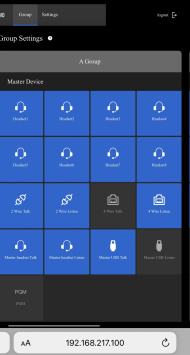 B Group - Changed
B Group - Changed 
Equipment and Power
Pit: Uses of power = 13amp and 16amp. Our DQ rack which distrobutes signal to the digico desk is powered by 16amp found in the upsatge left corner of the pit. we postioned our DQ rack at the front of the pit, DSL. This was because we had four subs on this show, two B1 - L + R and two C7 Subs - L + R. these were powered by amplifiers inserted in our DQ rack in the pit. We avoided long unwated runs of NL4(speaker cable) and were able to concentrate all of our cable runs at the front of the pit where easily accesible and out of the way of band memebers.
Nineteen microphones were used in our pit band. Microphone types included: DPA 4099 - Violins, Violas, Bass, Cello which were all attached using specific clips designed for each instruments. For example a violin clip:
Piccolo Snare Drum - AT2020 Snare Drum - AT2020 Bass Drum - SM89 Tom-toms - SE300 Cymbal (Suspended) - SE300 Small Choke Cymbal- SE300 Horn I - beta 57 Horn II - beta 57 Trumpet - MD441
Each instruments microphone is connected to the DQ rack in the inputs section via XLR cable. Once connected the digico SD12 in use is able to pick up their signal via dnate network. We used three stage boxes around the pit in order to control the amount of cable needed. See Image below.
Our main cable run was along the front of the situated steel deck we used bungies to attach the cables to the steel rungs. This was because it is fast and easy to attach, adjust-access cable, strike and is much more environmentally friendly than tape. The cables consisted of XLR, Cat 5 ethernet and power for our stage boxes
Some instruments it made sense to hang mics,The infrastructure of the pit allowed us to easily hang mics. See image below:
Pit PLan:
We layed black painted steel deck, this blacked out the grey floor in the pit, allowed us to manage cable runs better and added a certain elegance to the pit. We also rigged a black drape around the back of the pit to cover any unwanted storage.
In order for each band member to essentially have their own foldback we used a behringer powerplay system, beheinger base station connected to two distrobuters which distrobuters to each musicians powerplay unit, this small P16-M mixer allowed the musicician to switch between different groups within the mix. for example, strings Vox etc. Adjust volumes, pan, add effects etc. Headphones were required.
Pit Steel Deck Layout
Onstage:
Lighting
Lighting Set Pieces
The LX dept had some interesting obstacles to overcome in the implementation of the LX rig, as well as the design and manufacture of some practical set pieces.
Two Martin Quantum Wash units were rigged on a short 1.5m section of truss which was required to fly live during the show to mimic a tracking sun. In order to facilitate and easy controlled movement, TSD made use of the automation system and programmed the truss to move. Whilst the setting up of the automation winches and programming the cue was relatively easy, because the truss flew live, we also needed to ensure the operator had a clear view of the area that the truss flew in and out of. To do this, a setup of a digital HD low light camera was installed onto the LX boom directly below the truss, and the feed from the camera was routed through the house patch, to the automation programmers position US.

-
Truss Above Camera
-
Camera on Boom
-
Screens at Automation Control
With all of this in place, the LX Team then realised we needed to understand the curve/track timing of the automation cue, to allow us to try and replicate the speed and movement of the truss. This meant calculation a Velocity over Time graph:



![]()
![]()
This resulted in the LX OP being able to tweak the "DMX Profile" of the lighting cue using the percentage option in MA2 software to try and match the cue. By making the start of the cue run quickly, then remaining constant, and finally slowing, the Tilt of the moving head, closely matched the profile of the Automation cue. This allowed the beam of light from the fixture to remain focussed on one piece of set, whilst the physical height of the fixture was altered.
Two set piece items which LX were asked to solve were a bedside lamp and picture frame, that could both be operated wirelessly and be under DMX control to avoid performers having to switch them on and off on cue.

The bedside lamp was a relatively easy project, and just required the changing of the sourced lamps bayonet lamp holder to an Edison screw, so that we could make use of a stock LED filament lamp that can operate at 12v. A hired wireless DMX system comprising of a transmitter, powerful omni directional aerial, 3 channel 12v wireless dmx dimmer, and USB battery power system was used to provide 2 channels of dimming - one for the lamp and one for the picture frame. To modify the bedside lamp, we first tried using and bayonet B22 to Edison screw E27 adapter but this made the bulb sit too high above the edge of the lamp shade, so it was poking out! To remedy this the lamp holder was simply removed, rewired, and the plug removed to provide bare wire to attach to the dimmer:
-
Bedside Lamp with Adapter - bulb too high
-
Bulb and Adapter
-
Rewiring the bulb holder
-
Rewiring the bulb holder
Making the picture frame light up, took a little planning and forethought. First a box would need attached to the rear of the picture frame to give a suitable depth to mount some LED product. From experience, it was decided the LED should be mounted at 90degrees to the actual picture, and a "lightbox" created to give as soft a light source as possible to illuminate through the image. The back box was constructed from 5mm black foam board, and lined with a fresh uncrinkled piece of aluminium foil. Some 2 cell 4000k warm white led modules were mounted around the edge of the box. This box was then covered by a piece of Lee diffusion to again soften the light source.
-
Picture Frame LED modules
-
LED modules mounted in back box with foil
-
Diffusion
-
Frame mounted on back box with diffusion
-
Frame mounted on back box with diffusion
-
Velcro tab securing back box to frame
-
Test photo in frame
-
Wiring both the lamp and picture frame to dimmer
Lighting Design
LIGHTING PLANS
Version 1 of the Lighting Plan - created in June 2023 before rehearsals had started.
Version 4 of the Lighting Plan - this was the final rig plan that was used for the get-in.
Version 5 of the Lighting Plan - this is the updated plan post first preview.
Rig change notes.
Lighting Magic Sheet - this is what I used to plot the show from.
LIGHTING CUE SHEET
LIGHTING NOTES
Production Electrics
Stage Management
Rehearsal Room
Due to the functionality of the set, we aimed to have as much of the set in the rehearsal room for as long as possible. When blocking started, we had the swing set, slide and stepping stones. This had to be extensively risk assessed.
When the bedroom truck was brought in, it was a huge change for the cast. All other set pieces are things that you would see day to day, but with the staircase that leads to nowhere and the scale, it took some time to get used to. We spent 1.5 hours when it was first brought in getting used to moving it. This was then done again when we got to stage as part of the scene change rehearsal.
Fight and Lift Calls
Into The Woods is not a show that you would think would require a large fight call but there are a surprising number of fight moments, especially in our production. Raymond Short was brought on as our fight director to assist with these moments and helping the cast feel comfortable with all the falls on stage.
Our adaptation also involved several complex lifts that were Choreographed by Jack Webb which had to be run daily. Several of these where large group lifts as an ensemble approach was taken to this show. We also had falls that involved the rope hair (Rapunzel’s hair that would stretch the width of the stage) and skipping which we would run daily.
Between these two factors, fight and lift call daily was 30 minutes. To try and reduce the time, Iz and Robyn split the moments between them, Iz focusing on Lifts as they had been there during choreography, and Robyn focusing on Fights as they had been at all of Raymond’s sessions.
Prop Makes
Setting and Running List
Media:ITW_Master_Running_List.docx
Props Shelves
Video
Photos
Production Photos
Behind The Scenes
Photos By:
and all crew members




